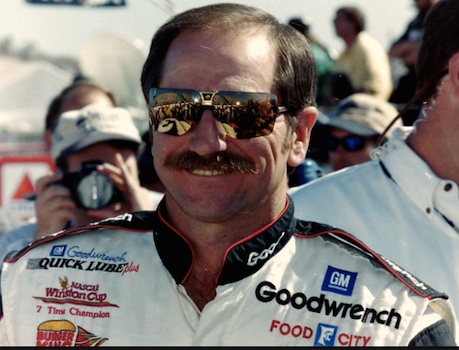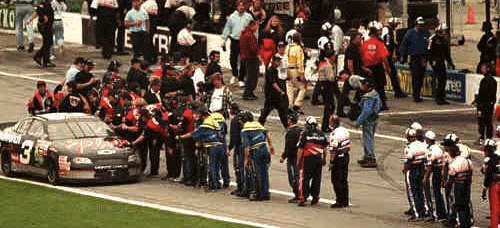
 Photos and video for Headline Surfer / The entire 1998 Daytona 500 with Dale Earnhardt taking the checkered flag.
Photos and video for Headline Surfer / The entire 1998 Daytona 500 with Dale Earnhardt taking the checkered flag.
DAYTONA BEACH -- It can easily be argued to a jury of 12 NASCAR fans that the single greatest race in the history of stock car racing beyond a reasonable doubt is the 1998 Daytona 500.
For this particular race on Feb. 15, marked seven-time Sprinrt Cup champion Dale Earnhardt's conquest of the Great American Race after 19 previous heart-breaking tries.
His 71st cup victory also snapped his 59-race winless streak stretching back to Atlanta Motor Speedway in March of 1996. Twice, he led at the white flag, but failed to gain the checkered flag in the Daytona 500 until breaking through in 1998.
Because today is the 56th running of the Daytona 500, Headline Surfer® is counting down its list of the 10 greatest Daytona 500s, with Earnhardt's 1998 clearly etched as No. 1 overall, not only for the 500, but the history of NASCAR racing, taking into consireration all racing circuits and track venues.
The 1998 race wasn't spectacular for racing in particular, but rather the energy and anticipation building among the racing spectators as each of the 200 laps began to wind down to those precious few.
With two laps to go, Lake Speed and John Andretti tangled and Earnahardt raced to the caution flag ahead of Bobby Labonte and then made the final lap under caution to finally conquer Daytona for himself and No. 3 car owner Richard Childress.
Top 10 greatest Daytona 500 races:
1. 1998: Earnhardt conquers Daytona

2. 1976: Petty & Pearson wreck, but Silver Fox crosses finish line
This 18th annual Daytona 500 came down to a last lap duel between Richard Petty and David Pearson, two of the top 3 back then along with Cale Yarborough, who wasn't a factor in this finish. Coming off of turn 4, the two made contact and struck the outside wall with Petty spining uncontrollably, but just short of the finish line. Though Pearson, known as the "Silver Fox," was behind, he was able to limp by in his mangled wreck to cross the finish line and the waving of the checkered flag.
3. 1979: Petty wins 6th Daytona 500; Yarborough & D. Allison in fisticuffs
The 21st Daytona 500 marked the sixth time Richard Petty had won the Great American Race. A crash and fisticuffs between leaders Cale Yarborough and Donnie Allison, along with Donnie's brother, Bobby, brought national publicity to NASCAR. Motorsports announcer and editor Dick Berggren said: "Nobody knew it then, but that was the race that got everything going. It was the first 'water cooler' race, the first time people had stood around water coolers on Monday and talked about seeing a race on TV the day before. It took a while – years, maybe – to realize how important it was." The 1979 Daytona 500 was the first 500-mile race to be broadcast in its entirety live on national television in the U.S.
4. 2004: Dale Earnhardt, Jr. wins three years after father's death
The Daytona 500 was run on on Feb. 15. Dale Earnhardt, Jr. won the race, his first Daytona 500 victory, exactly six years to the day after his father, Dale Earnhardt,Sr., won his first and only Daytona 500, while Tony Stewart finished second and rookie Scott Wimmer finished third. Before the start of the race, several cars had to move to the rear of the field: engine changes for polesitter Greg Biffle, This allowed Gatorade Duel No. 1 winner Dale Earnhardt, Jr. to became the new polesitter and led the opening laps. Earnhardt passed Tony Stewart on lap 181 of the 200-lap race to win his first Daytona 500, exactly three years after his father's fatal crash on the final lap of the 2001 Daytona 500.
5. 2001: Michael Waltrip's victory obvershadowed by Dale Earnhardt's last-lap fatal crash
The Daytona 500 was run on Feb. 18, with Bill Elliott on the pole. The race was won by Michael Waltrip, in his first contest in the No. 15 car for Dale Earnhardt, Inc, with Dale Earnhardt, Jr., in the No. 8 Budweiser Chevrolet taking second place. It was Waltrip's first victory of his career in his 463rd start. Waltrip's win was overshadowed by the horrific last-lap crash of Dale Earnhardst, coming off turn 4, who was in third place at the time, when he was bumped by Sterling Marlon, which caused a collision with driver Ken Schraeder and the No. 3 hitting the outside retaining wall head-on. Earnhardt, Sr., was killed instantly, the result of a basilar skull fracture. For those watching the race on TV, FOX Sports had the telercast for the first time and the broadcast focused on color commentator Darrell Waltrip, the retitred 1989 Daytona 500 winner, cheering for his brother. At one point after Michael Waltrip took the checkered flag, the elder Waltrip throttled back from his cheers to ask, "I hope Dale is OK, I guess he's alright, isn't he?"
6. 1962: Fireball Roberts dominates in caution-free race
On Feb. 18, Fireball Roberts, driving the No. 22 Pontiac, led 144 of the 200 laps in dominating fashion, beating Richard Petty to the checkered flag by 27 seconds, in a caution-free race. Having led the 1961 Daytona 500 before a blown engine knocked him out, Roberts in 1962, ate a bologna sandwich, strapped himself into his car and dominated the 500. Sadly, though, the racer who called Daytona Beach home, would die two years later following fiery crash in the 1964 World 600 in Charlotte, N.C.
7. 1999 Jeff Gordon holds off Dale Earnhardt
The 41st running of the event, was held Feb. 14, and won by the pole sitter, Jeff Gordon. This race is known for Gordon's daring three-wide pass on Rusty Wallace and Mike Skinner. Gordon passed Wallace after ducking to the apron, nearly plowing into the damaged car of Ricky Rudd. Skinner jumped to the outside and they raced three-wide for three laps until Dale Earnhardt gave Gordon the needed push. The race was also known for a determined Dale Earnhardt repeatedly trying to pass Gordon for the lead on the final lap, but Gordon beat Earnhardt to the finish. The race had a 13-car pileup on lap 135, causing eventual series champion Dale Jarrett to flip twice. He was uninjured.
8. Lee Petty wins inaugural race over Johnny Beauchamp in reverse decision
The inaugural Daytona 500 was held Feb. 22, 1959, at Daytona International Speedway, which was built the year before. This race actually included convertibles, 20 oif them among the 59 cars in the rce. Among the convertible drivers was Richard Petty. Bob Welborn, winner of the 100-mile Grand National qualifying race earlier in the week, started on the pole position.Shorty Rollins won the Convertible qualifying race and started second. Lee Petty, father of Richard Petty, battled with Johnny Beauchamp during the final 30 laps. Petty took the lead with 3 laps left, and led at the start of the final lap. Petty and Beauchamp drove side by side across the finish linefor a photo finish. Beauchamp was declared the unofficial winner, but three days later after reviewing a photo of the finish, Petty was declared the offcicial winner.
9. 2011: Rookie Trevor Bayne youngest driver ever at 20 to win
In just his second NASCAR start, Revor Bayne, one day removed from this 200th birthday won the 2011 Daytona 500 held Feb. 20. holding off a slew of far-more experienced drivers like Carl Edwards, Bobby Labonte, Davifd Gilliland and Kurt Busch. The rce featured 74 lead changes among 22 drivers, but Bayne, driving the No. 21 Motorcraft Ford for the Wood Brothers also became the second driver to win the race in his first attempt, followinhg in the footsteps of Lee Petty in 1959.
10. 1967: Indy 500 champ Mario Andretti wins the Great American Race
Bonus videos: Crashes that led to greater NASCAR safety features & the reality of fatalities


 Photos and video for Headline Surfer / The entire 1998 Daytona 500 with Dale Earnhardt taking the checkered flag.
Photos and video for Headline Surfer / The entire 1998 Daytona 500 with Dale Earnhardt taking the checkered flag.
